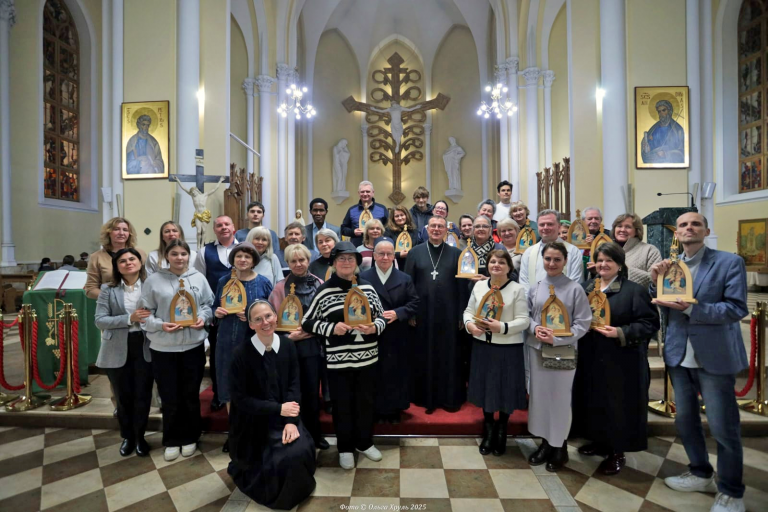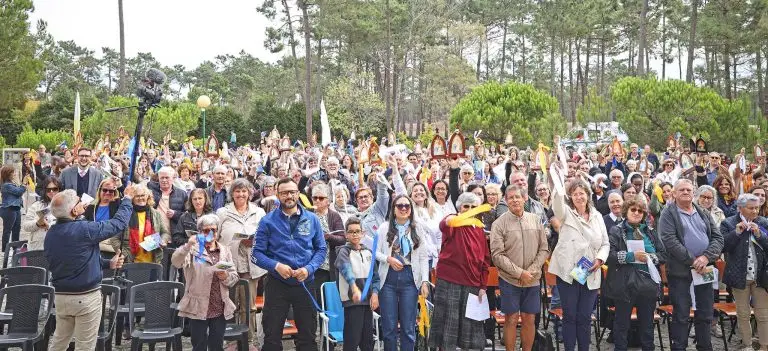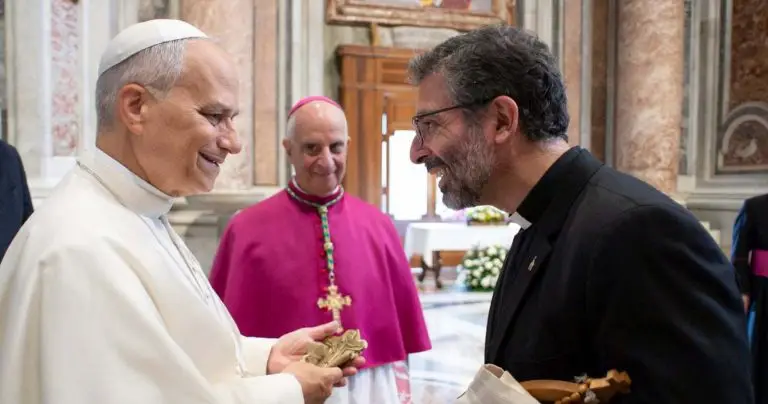At the International Congress of the Pilgrim Mother in Santa Maria, Brazil, the morning of Mary’s day, September 12, was dedicated to meditating on the signs of hope in the life of Venerable João Luiz Pozzobon. The Clube das Dores, where the event is being held, is already home to everyone who arrives full of joy and increasingly united with one another through fellowship and sharing in the mission.
She is the first missionary
Fr. Arkadiusz Sosna, from the International Coordination of the Schoenstatt Apostolic Movement, celebrates the Holy Mass. The songs of the Sisters of Mary choir are a praise to Mary on the day of her most holy name. In his homily, the priest establishes a relationship between the name of Mary and the mission of Venerable Pozzobon, always accompanied by a thought from St. John Paul II.
He said that “today’s feast reminds us of the closeness, protection, and strength that Mary’s name holds… She is the first missionary; she said her ‘yes’ and became the first to bring Christ to the world.” He emphasized that the family is the place of first evangelization. João’s mission “began in his own home, in his ‘Nazareth,’ before the image of the Pilgrim Mother. Together with his wife, Victoria, he made his home a place of encounter with God. His home became the first ‘home shrine.'”
Where Mary enters, Christ enters
Fr. Arkadiusz also speaks of “the mission of the laity,” following the example of Pozzobon, who “was not a theologian or a religious, but a simple Christian with a big heart.” He concludes by saying that “Mary is the star of evangelization and the mother of everyday life. Today, when the Church faces religious indifference and moral confusion, we must rediscover the power of simple gestures and Mary’s presence in everyday life. Because where Mary enters, Christ enters, as in Elizabeth’s house.”
At the end of Holy Mass, Fr. Arkadiusz greets all the Sisters of Mary on their name day and invites them to gather for a photo.

Eulalia Solé, from Spain, comments on this encounter: “It is very moving, with very positive reflections that fill me with hope in the work of the Mother of God in hearts and inspire me to a deeper renewal of my dedication to the Apostolate. At this Congress, I was deeply impressed by the testimony of the local bishop and Monsignor Melchor about their vision of the life and person of João Pozzobon and what he represents for the Church today. In this celebration of 75 years, I have met many people from so many different countries and cultures who share a love for the Blessed Mother, the experience that the world needs her, and burning hearts to bring her to the world.”
The Pozzobon family is present
After the break, the formative moment is led by the Schoenstatt Youth of Santa Maria and the Schoenstatt Fathers, who, through texts, videos, and songs, present a reflection on João Luiz Pozzobon, an example of a missionary of hope who motivates the Apostolate of the Pilgrim Mother into the future.

Then the children of the Venerable Humberto, Petrolina, Vilma, and Nair Pozzobon enter, also remembering their deceased siblings, Otilia, Eli, and Ari. Nair shares: “For me, my father was always a saint. Sometimes he asked us, his children, for forgiveness, but it is we who should ask him for forgiveness. We are happy that he is a saint.” Petrolina: “My father was a great hero who won many souls for God… he was an extraordinary father, from every point of view.” She then addresses her father, thanking him for all that he was.
My father wanted a happy family
Vilma says she can only give thanks: “My father’s life, with his family, was very joyful, very happy.” Humberto says he is very happy to be here. “He is a missionary of hope, inspired by the Holy Spirit. His joy was to pray the rosary with families, and he said that you cannot abandon your family. He was kind, loving, taught us to be modest, took care of our good appearance, and wanted his family always to be happy.”
Then all the other members of the Pozzobon family enter, bringing the picture of the Mother Thrice Admirable of Schoenstatt from the Pozzobon Home Shrine, as well as the latest picture with the motto of the year and the “obedience notebook,” in which he wrote down instructions for the education of his children.

João continues on mission
As a sign of hope, in service to those most in need, some people whose relatives were residents of Villa Noble de la Caridad and others who take care of the blue, pink, and white chapels enter. A resident of the white chapel, “João continues his mission, going out from the shrines to the communities,” recounts how the Venerable had the idea of building the white chapel in 1960. “João was always concerned about families, both in terms of religion and natural needs. For example, the families who lived around the white chapel did not have drinking water, so Pozzobon built a well there. The children attended schools that were very far away, so he built a small school where they could study in their early years. He also helped couples legalize their marriages by celebrating community weddings.”
Denise Moro enters with the Pilgrim MTA from the schools, representing all the young people and children whom the Venerable visited. She was one of the girls who was visited and later became Pozzobon’s secretary. She shared her experiences of the visits as a child. “He established the children’s bond with the Blessed Mother, and we bonded with him,” says Denise. She says that the Venerable encouraged the children to ask for a grace from the Mother Thrice Admirable of Schoenstatt, and the following year, he invited them to share if they had received it.
We are just beginning
The Schoenstatt youth enter with the Heroic Pilgrim MTA, with which Pozzobon worked with the youth, and give their “battle cry.” The reflection on Pozzobon’s death is based on Deacon Ubaldo’s accounts of how he experienced the moments after the accident and how painful it was to learn that he had died.
Next, the accident involving the Original Pilgrim MTA during her visit to Brazil was mentioned, along with Pozzobon’s words when the Apostolate celebrated its 30th anniversary: “We are just beginning.” The songs and images showed the beginnings of the Apostolate with Pozzobon, and then the message was that now the mission belongs to us.
The progress of the beatification process of Venerable Pozzobon is a sign of hope for all of us. The event concluded with the recitation of the Hail Mary in all languages. Next, a pilgrim image was presented, in which a relic of the venerable and a fragment of the wood from the original pilgrim image, removed after the accident she suffered, are embedded. Accompanied by the voice of Pozzobon, everyone sang: “My heart belongs only to Jesus…”, and a deacon gave the blessing.
The great and unexpected gift
Fr. Vitor Possetti then explained that each participant would receive the mission to continue the work begun by Venerable João Luiz Pozzobon. The participants received a small pilgrim image with the relics mentioned above. Emotion filled their hearts: with tears and great devotion, the missionaries received the little Pilgrim MTA, with the mission of continuing the great and beautiful mission of Venerable Pozzobon.


“Crazy with love.” This is the phrase with which Marycarmen Vázquez Sánchez, from Mexico, sums up the atmosphere of the entire congress. “Childlike dedication to the mission, different languages, but all united in one heart. There is a desire to learn more; the magnanimity of the missionaries,” she adds.
The difficult choice…
In the afternoon, the participants had to make a difficult decision: go to Vila Nobre and pray the Way of the Cross, visit the Shrine of the Brothers of Mary in Itaara, go to the House Museum where the Venerable Pozzobon lived, or be with his children, listen to their stories, and ask questions. Meanwhile, representatives of the Apostolate from different countries, together with the International Coordination, worked on the consensus document that would define the essential aspects of the Schoenstatt Pilgrim Mother Apostolate for all countries.

A traditional and family-oriented evening
The evening is a family celebration at the Gaucho Traditions Center. There was a dinner with traditional foods, music, and dances from the gaucho culture. The Crnjak family (Dino, Anita, and Luka) from Croatia cannot contain their joy: “Participating in this jubilee is a special honor. We are especially moved to be gathered here, with different languages, but all united in love. It’s simply incredible! There are games, a procession, the burning of the Capital of Grace offerings, and workshops. We can’t leave anything out… But above all, we are delighted with the welcome from our hosts, their kindness, and affection. We want to express our sincere gratitude to the volunteers and the sisters. They have enriched us.”
Translation: Sr. M. Lourdes Macías



